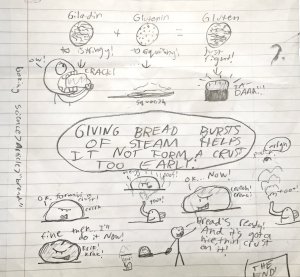Using Drawings for Formative Assessment
Asking middle and high school students to sketch something they’re learning can give teachers a clear sense of what they do and don’t understand.
Your content has been saved!
Go to My Saved Content.Formative assessments, when done regularly at key points during the learning process, are windows into what students misunderstand or question about a concept or topic. Inviting students to process and express their understanding with drawings offers teachers incredible insights about what instructional moves to make next.
Asking Students to Draw as They Learn
Drawing while we learn allows us to capture a concept, image, event, or object and frees up cognitive space so that we can begin to think critically. If I quickly sketch a few characters from a novel with a small but key detail distinguishing each one, along with arrows depicting their relationships across generations, I can now think critically about those relationships, how characters influence each other, and how they develop throughout the story. Similarly, if I roughly sketch elements of a scientific process, I can begin to think about their functions and how they are integrated.
Drawing as we learn requires abstract and metaphorical thinking about the content, which helps us retain and understand it in more sophisticated ways. A student who draws as they learn considers the following:
- How should I represent the relationship between these parts?
- How large/small should I draw these parts?
- What shape should they be?
- Where do I place each part?
Because students make many decisions as they translate content into visuals, teachers can uncover their preconceptions, their misconceptions, the depth of their understanding, and what excites them about the content.
Building Confidence in Drawing as a Learning Tool
Drawing has significant learning benefits, and it’s important to integrate it into a full academic experience. We can equip students with basic tools to become confident in drawing and allow them to use various methods to process and express their thinking. We can ignite interest in a topic by offering variety in modes of learning. Also, leveraging intuitive thinking appeals to students’ diverse skills.
Students don’t need developed artistic skill to experience the cognitive benefits of drawing as they learn. But, it’s also important to ease any anxiety and dispel myths about visual work.
1. Offer drawing as one of a few options for students to process and demonstrate their learning.
2. Model the drawing option you offer. Replace fixed-mindset language like “I can’t draw” with narration describing your process: “I want to show that the elements build on each other, so I’ll draw boxes on top of each other.”
Dan Santat’s series #DrawLikeAKid demonstrates how to draw a lot of things with just a few shapes and the letters of the alphabet.
3. Prompt students to reflect on their experiences in drawings so that they begin to understand it as a helpful learning tool.
- How well did I recall the material after having represented it in my drawings?
- When would drawing as I learn be useful? When is it not useful?
Using Students’ Drawings to Inform Instruction
The feedback we offer on student drawings and the instructional choices we make next are as critical as the drawing.
Students mimic the jargon or vocabulary they read or hear, which can obscure what they actually understand. As a formative assessment, verbal communication can be problematic because it can be difficult for the teacher to grasp what students truly understand. When students draw as they explain, it’s almost impossible to obscure their knowledge. Obvious misunderstandings, along with subtler mistakes, make their way into students’ drawings.
Here are some ways to integrate drawing as formative assessment:
- Line-color-symbol: Draw a line, choose a color, or select a symbol that represents your current understanding of the concept we are learning. Be prepared to explain your choice.
- Draw an image that represents (gravity, how an argumentative essay is structured, the relationship between the protagonist and the antagonist, the limbic system).
- Using only simple shapes (circles, squares, triangles), represent the relationships between (characters, principles, events, laws, mathematical concepts).
- Create a comic/sequential art to represent a system, to distill key elements of a story or event, or to order essential steps of a process and represent cause-and-effect relationships.
To effectively use students’ drawings as formative assessment data, consider the following as you examine their visuals:
- What facts, relationships, sequences, etc., does the student understand?
- What key elements have been overlooked?
- What factors are somewhat misrepresented?
- How were certain factors, relationships, details, etc., represented?
- How do students’ drawings compare? What patterns do you see? What is distinctive about some of them?
- What insights do their drawings offer about the content?
While reviewing a middle school student’s visualization of the scientific process of making bread (below), I notice that he understands some key concepts: He knows there are two proteins that bind to form gluten, and his simple drawings demonstrate why each wouldn’t, on its own, result in glutenous fluffy bread. But I wonder if he understands the roles that amino acids, water, mixing, and kneading play in this equation.

In my feedback, I’d acknowledge the elements he correctly illustrates. Then, to determine if he understands the complexity of the process, I‘d ask him: Are these the only elements needed for the two proteins to result in gluten? What could be missing? Where and how could you draw it?
When we see thinking represented in visual form, we—students and teachers—get valuable insights into the concepts involved. We learn from what others see, the choices they make to represent an idea, and even the misconceptions they might have.
Thinking is messy—we generally don't follow a rigid and consistent procedure to think through problems, though a steady step-by-step process is often used to solve a math problem, form a hypothesis, or write an argument. Offering students structured opportunities to represent their thinking with drawing allows them to demonstrate their unique processes for thinking about complex concepts and problems and arriving at creative solutions.
When we see their thinking, we discover the subtleties of what they do and do not yet understand, so we can better prepare to solidify their understanding and build on it in our next lesson.
